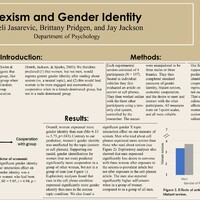Gender Identity and Sexist Attitudes
Item
Poster Number
13
Poster Title
Gender Identity and Sexist Attitudes
First Presenter
Neli Jasarevic
Other Contributors
Brittany Pridgen
Abstract
Introduction: Sexism remains widespread in society. The motivation to participate in collective efforts to address group-based discrimination is affected by levels of group identification. Social identity theory suggests that people who belong to impenetrable groups, like gender, identify more strongly with the group when it is discriminated against. This should motivate intragroup interactions and cooperation. We tested this idea experimentally by making the prevalence of sexism salient (or not) to male and female participants, and then giving them the opportunity to cooperate and share a discussion with three others, either all males or all females.
Methods: Each experimental session consisted of 4 participants (N=197). Seated in individual cubicles they first evaluated a campus newspaper article on the prevalence of sexism or cell phones. They then worked online with the three other participants using a text-only chat system, controlled by the researcher. The names were manipulated to be three males or three females. They then completed scales to assess gender identity, hostile and benevolent sexism, self-esteem, personality, and the desire to cooperate, meet, and work together with the other participants.
Results: The women expressed significantly greater gender identity than the men but were unaffected by the manipulation. The men, in contrast, were affected by the manipulation. They expressed significantly less gender identity after exposure to the sexism-is-prevalent message than the control message. The men also expressed significantly less desire to converse with three women after exposure to the sexism-is-prevalent article but not after exposure to the cell-phones article. The men also reported higher self-esteem when in a group of women compared to in a group of all men. Men expressed significantly higher levels of benevolent and hostile sexism, regardless of experimental condition. Gender identification amongst the women in our study predicted significantly greater cooperation and a desire for further interaction when in a group of women, relative to a group of men.
Discussion: Many of our findings are consistent with social identity theory and models of ambivalent sexism. That our sexism salience manipulation affected men more than women may be due to the fact that sexism is routinely salient to women, but not to men. Our results suggest that men may be reluctant to engage in mixed gender discussions of sexism. Strategies can be employed to push this much needed conversation forward to enact widespread sociocultural changes.
Methods: Each experimental session consisted of 4 participants (N=197). Seated in individual cubicles they first evaluated a campus newspaper article on the prevalence of sexism or cell phones. They then worked online with the three other participants using a text-only chat system, controlled by the researcher. The names were manipulated to be three males or three females. They then completed scales to assess gender identity, hostile and benevolent sexism, self-esteem, personality, and the desire to cooperate, meet, and work together with the other participants.
Results: The women expressed significantly greater gender identity than the men but were unaffected by the manipulation. The men, in contrast, were affected by the manipulation. They expressed significantly less gender identity after exposure to the sexism-is-prevalent message than the control message. The men also expressed significantly less desire to converse with three women after exposure to the sexism-is-prevalent article but not after exposure to the cell-phones article. The men also reported higher self-esteem when in a group of women compared to in a group of all men. Men expressed significantly higher levels of benevolent and hostile sexism, regardless of experimental condition. Gender identification amongst the women in our study predicted significantly greater cooperation and a desire for further interaction when in a group of women, relative to a group of men.
Discussion: Many of our findings are consistent with social identity theory and models of ambivalent sexism. That our sexism salience manipulation affected men more than women may be due to the fact that sexism is routinely salient to women, but not to men. Our results suggest that men may be reluctant to engage in mixed gender discussions of sexism. Strategies can be employed to push this much needed conversation forward to enact widespread sociocultural changes.
Year
2022
Embargo
no embargo
